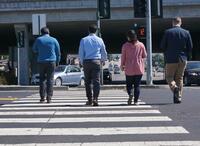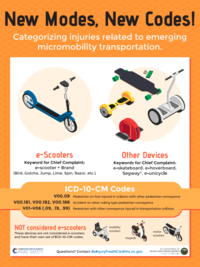SafeTREC research on vulnerable road user safety
Bicycle Crash Corridors

While spot safety approaches are effective and necessary, they address the safety problem in a reactive manner and on a very small scale. To complement spot identification methods, transportation safety practitioners have shown an increased interest in developing approaches that can also lead to the implementation of improvements in a proactive manner such as corridors. This research proposes a high-level specification for safety corridors, and studies the performance of three approaches to identify bicycle crash corridors. Learn more.
Research Team: Aditya Medury and Offer Grembek.
Creating an Inclusive Bicycle Level of Service Performance Measure
Bicycle level of service (BLOS) is an essential performance measure for transportation agencies to monitor and prioritize improvements to infrastructure. However, existing measures do not capture the nuances of bicycle activity on different types of road facilities. This research will conduct an in-person bicyclist user experience survey using SafeTREC’s virtual reality bicycle simulator and an online survey in at least two languages, including English and Spanish. Learn more.
Research Lead: Julia Griswold
CSCRS Clearinghouse for Bicyclist and Pedestrian Safety-Related Data

Pedestrian and bicycle safety researchers spend a high percent of a project budget finding, obtaining and organizing data sources, which limits the time spent on analysis and causes such studies to be costly and not as common as needed. The purpose of the CSCRS National Pedestrian and Bicycle Safety Data Clearinghouse is to help connect researchers to the data they need to conduct robust studies of pedestrian and bicyclist safety. The goal is to greatly increase the quality and quantity of pedestrian and bicyclist safety research in the U.S. Learn more.
Research Team: Krista Nordback, Wes Kumfer, Seth LaJeunesse, and Julia Griswold.
Evaluating the Safety of Adopting a Stop-as-Yield Law for Cyclists in California
Cycling is an affordable and sustainable mode of travel to mitigate traffic congestion, reduce air pollution, and complement public transport in cities. It increases physical activity and promotes public health. “Bike-friendly” laws such as Idaho’s 1982 Stop Law (Idaho Statutes § 49-720) allows cyclists to treat stop signs as yield signs and red traffic lights as stop signs, allowing riders to maintain their energy and momentum. This research will examine the potential safety impacts of stop-as-yield legislation in California. Learn more.
Research Lead: Offer Grembek
Evaluating the Safety Effects of Decriminalizing Jaywalking on California Streets
This research project will review major scholarly databases, including Pubmed, TRIS, and others for articles and reports documenting risks from decriminalizing jaywalking including details such as time from implementation of the law/regulation, crash type, level of injury(ies), and other considerations. The team will use the information collected to estimate the impact of decriminalizing jaywalking in California. Learn more.
Research Lead: David Ragland
Pedestrian Crash Hot Spots

Network screening techniques are widely used by state agencies to identify locations with high crash concentration, also referred to as hot spots. However, most of the research in this regard has focused on identifying highway segments that are of concern to automobile crashes. In comparison, pedestrian hot spot detection has typically focused on analyzing pedestrian crashes in specific locations, such as at/near intersections, mid-blocks, and/or other crossings, as opposed to long stretches of roadway. In this context, the efficiency of the some of the widely used network screening methods has not been tested.
In order to address this issue, a dynamic programming-based hot spot identification approach is proposed which provides efficient hot spot definitions for pedestrian crashes. Learn more.
Research Team: Aditya Medury and Offer Grembek.
Pedestrian Injury/Fatality: Impact of Ethnicity and Low Income - A Research Synthesis of the Literature
This project will conduct a thorough review of articles/reports documenting risk patterns for pedestrian injury for Black, Hispanic, and Native American populations, including data sources (FARS or SWITRS, hospital data, etc.), main findings, limitations, and reports that address the interaction of ethnicity and income. Learn more.
Research Team: David R. Ragland.
Safety Impacts of Vehicle Weight on Vulnerable Road Users
As with the rest of the nation, the vehicles on the road in California are changing. With the transition from sedans to SUVs, California’s vehicle fleet is getting larger and heavier. The share of fatalities that are vulnerable road users is also changing, as more pedestrians and bicyclists are struck on our roads. The aim of this project is to combine data on vehicles registered in California over the past decade with data on fatal crashes to explore if larger vehicles are involved in more fatal vulnerable road user crashes per registered vehicle than smaller vehicles. Learn more.
Research Team: Matthew Raifman, Amalia Stahl, and SangHyouk Oum.
Understanding Micromobility Safety Behavior

The purpose of this study is to accelerate shared learning around micromobility safety impacts and to fast-track improvements to injury surveillance of emerging modes such as e-scooters and related micromobility devices (e-bikes, electric skateboards, hoverboards, etc.) used on and around city streets, etc. The primary aim will be vehicles in shared mobility systems. Learn more.
Research Team: Christopher Cherry, Laura Sandt, and Susan Shaheen.
